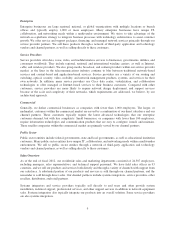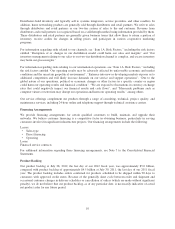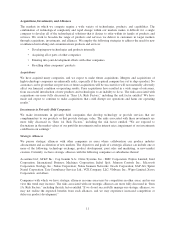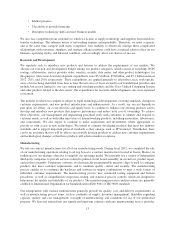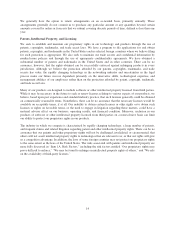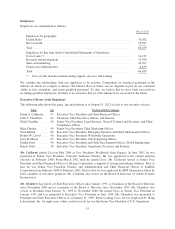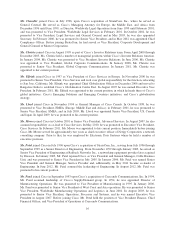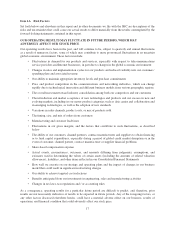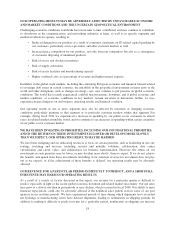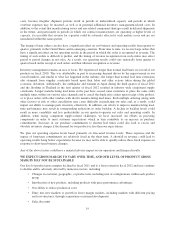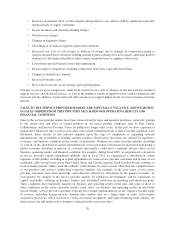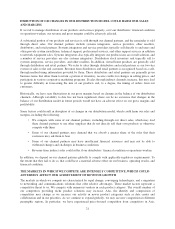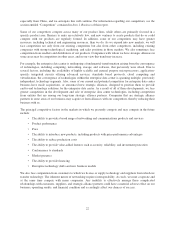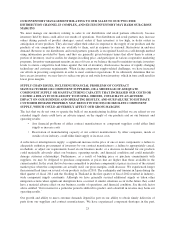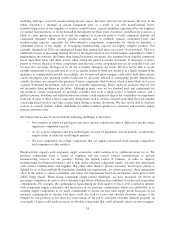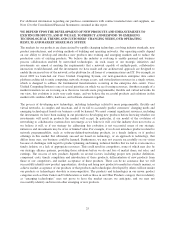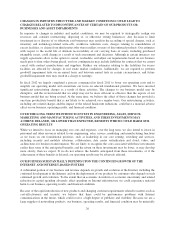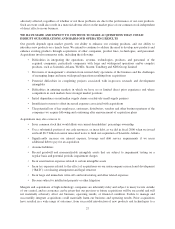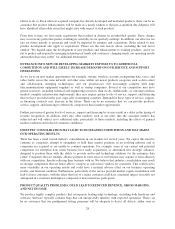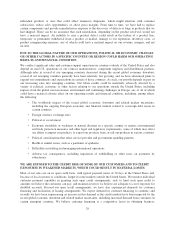Cisco 2012 Annual Report Download - page 27
Download and view the complete annual report
Please find page 27 of the 2012 Cisco annual report below. You can navigate through the pages in the report by either clicking on the pages listed below, or by using the keyword search tool below to find specific information within the annual report.costs, because irregular shipment patterns result in periods of underutilized capacity and periods in which
overtime expenses may be incurred, as well as in potential additional inventory management-related costs. In
addition, to the extent that manufacturing issues and any related component shortages result in delayed shipments
in the future, and particularly in periods in which our contract manufacturers are operating at higher levels of
capacity, it is possible that revenue for a quarter could be adversely affected if such matters occur and are not
remediated within the same quarter.
The timing of large orders can also have a significant effect on our business and operating results from quarter to
quarter, primarily in the United States and in emerging countries. From time to time, we receive large orders that
have a significant effect on our operating results in the period in which the order is recognized as revenue. The
timing of such orders is difficult to predict, and the timing of revenue recognition from such orders may affect
period to period changes in net sales. As a result, our operating results could vary materially from quarter to
quarter based on the receipt of such orders and their ultimate recognition as revenue.
Inventory management remains an area of focus. We experienced longer than normal lead times on several of our
products in fiscal 2010. This was attributable in part to increasing demand driven by the improvement in our
overall markets, and similar to what has happened in the industry, the longer than normal lead time extensions
also stemmed from supplier constraints based upon their labor and other actions taken during the global
economic downturn. Additionally, the earthquake and tsunami in Japan during the third quarter of fiscal 2011
and the flooding in Thailand in the first quarter of fiscal 2012 resulted in industry wide component supply
constraints. Longer manufacturing lead times in the past have caused some customers to place the same order
multiple times within our various sales channels and to cancel the duplicative orders upon receipt of the product,
or to place orders with other vendors with shorter manufacturing lead times. Such multiple ordering (along with
other factors) or risk of order cancellation may cause difficulty in predicting our sales and, as a result, could
impair our ability to manage parts inventory effectively. In addition, our efforts to improve manufacturing lead-
time performance may result in corresponding reductions in order backlog. A decline in backlog levels could
result in more variability and less predictability in our quarter-to-quarter net sales and operating results. In
addition, when facing component supply-related challenges, we have increased our efforts in procuring
components in order to meet customer expectations which in turn contribute to an increase in purchase
commitments. Increases in our purchase commitments to shorten lead times could also lead to excess and
obsolete inventory charges if the demand for our products is less than our expectations.
We plan our operating expense levels based primarily on forecasted revenue levels. These expenses and the
impact of long-term commitments are relatively fixed in the short term. A shortfall in revenue could lead to
operating results being below expectations because we may not be able to quickly reduce these fixed expenses in
response to short-term business changes.
Any of the above factors could have a material adverse impact on our operations and financial results.
WE EXPECT GROSS MARGIN TO VARY OVER TIME, AND OUR LEVEL OF PRODUCT GROSS
MARGIN MAY NOT BE SUSTAINABLE
Our level of product gross margins declined in fiscal 2011 and to a lesser extent in fiscal 2012 and may continue
to decline and be adversely affected by numerous factors, including:
• Changes in customer, geographic, or product mix, including mix of configurations within each product
group
• Introduction of new products, including products with price-performance advantages
• Our ability to reduce production costs
• Entry into new markets or growth in lower margin markets, including markets with different pricing
and cost structures, through acquisitions or internal development
• Sales discounts
19


